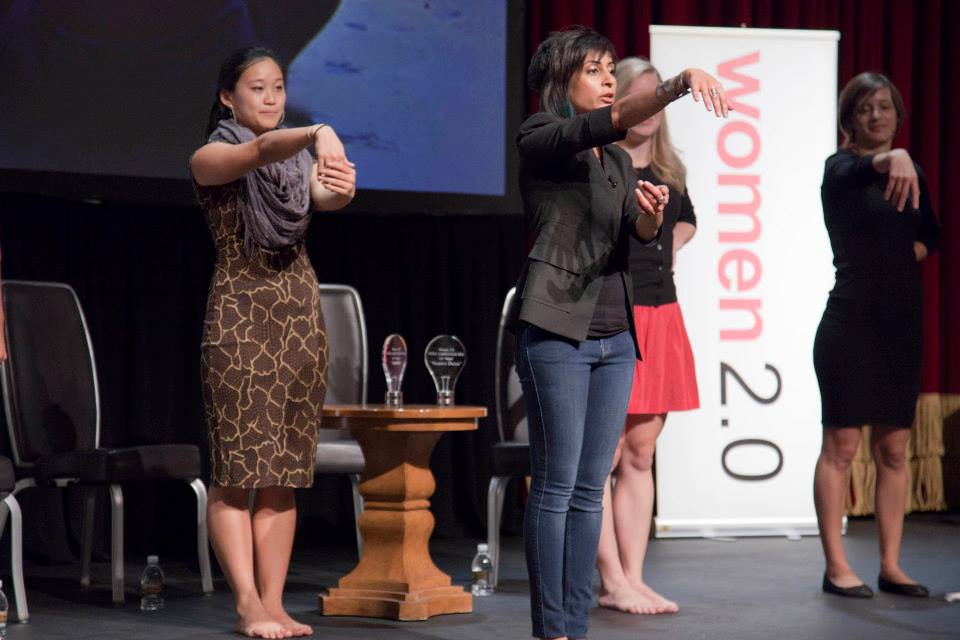
Women are geeking out putting their own touch of style on technology at Women 2.0 and Lesbians Who Tech Summit, two technology conferences geared just for the girls in San Francisco this month.
Women 2.0 kicks off its ninth conference today, February 14 – 15, bringing together upward of 1,000 women from all sectors of the technology world.
Two weeks later an estimated 600 techie dykes and their friends will gather for the first ever Lesbians Who Tech Summit, February 27 – March 2.
Leanne Pittsford, 32-year-old founder and chief executive officer of Start Somewhere Communications and the Lesbians Who Tech Summit feels that with the momentum the summit is already has that it will rapidly grow too.

“Every year our conferences get bigger and bigger,” says Shaherose Charania, 32-year-old co-founder and chief executive officer of Women 2.0. The conference has grown so large that within the past two years it’s held twice annually, usually in San Francisco, but last year the girl techies headed to the neon lights of Las Vegas and New York City.
This weekend cutting edge women – tech veterans to innovative up starts – are back in San Francisco.
Shaherose is excited about all of this year’s speakers, but she’s particularly proud to have Gwynne Shotwell, president and chief operations officer of SpaceX, Sarah Friar, chief financial officer and operations lead at Square; Julia Hartz, co-founder and president of Eventbrite; and Danae Ringelmann, co-founder of Indigogo.
SpaceX is an advanced rocket and spacecraft company that has revolutionized space technology. Square is the smartphone ecommerce device that allows users to shop on the go. Eventbrite has empowered promoters producing events big and small; and Indiegogo is helping small business owners find seed money to fund their ideas and projects through crowdfunding.
“I’m excited about all of them,” says Shaherose. “These are high impact companies and there is so much excitement around them.”
The women techies will discuss the latest and biggest tech discoveries, women getting on top of and leading the way in the tech industry, and as well as the return of 1999 with the new tech bubble with a session of breathing and stretching with Tech Yoga and more.
Shaherose believes that it’s important for women’s voices to be heard in technology, particularly because women are the majority of people who are using the new technologies that are being created.
“It’s important to have the contents delivered by women … we are talking about technology, but hearing it from the perspective of” women.
Gearing Up

Shaherose moved from Vancouver, Canada to Silicon Valley to feed her passion to be in technology by being in the birthplace and heart of innovation, but never imagined that she would be a part of launching a girl lead revolution.
She was perfectly comfortable often being the lone female in a sea of men at many of the technology networking events she attended, but she quickly discovered that women were being left behind. At these events friendships and alliances were being forged, ideas were being formed, and deals were being made and job and hiring opportunities were passed around.
“It was a situation where innovation was taking off and women were just not part of the creation of that,” says Shaherose.
Still, she wasn’t completely moved to change that dynamic until she began speaking with other women in the technology industry and a male friend of hers gave the final push throwing a bunch of his female techie friends, including Shaherose, into a room together one day.
“I want you to meet a couple of friends of mine and see what you can do for women,” Shaherose says her friend told her.
Technology: The Great Equalizer
Women 2.0 was born as the women talked about how technology was emerging and taking off as the new big influential companies and how women needed to be a part of that as technology was shifting the world in bigger and faster ways than previously imagined.
“What we realized was in an emerging market women would be becoming more and more of an equal,” says Shaherose. The group of women realized that women in developing countries would use technology to become entrepreneurs by obtaining microloans to fund their ideas and grow their businesses.
The effect would be on their daughters and sons who wouldn’t see gender as a barrier or an issue to achieve their dreams and goals any longer.
Even so, the women knew that those women and their children’s eyes would be turned to the West searching for the innovators, but they would only see Mark Zuckerberg, Steve Jobs, and Bill Gates. The X-factor was missing in spite of making up 30 percent of the tech industry, says Shaherose.
That needed to change along with showing the diversity within the industry.
“It’s our job here to have a platform to cover women and make news where the sources are women,” says Shaherose about tooting women innovators horns to inspire future women technology leaders.
The women technology leaders are lining up to speak at Women 2.0.
“I have too many women that want to speak at our conference and we can’t fit them in,” says Shaherose, about how many women technology leaders wanting and willing to speak at Women 2.0. “I’m not saying that they are a majority yet, there’s just more that are great.”
Even so, she realizes that it’s not enough. There still aren’t enough female investors, innovators, and founders of technology companies. That’s where Women 2.0 comes in.
Women 2.0 has grown from hosting monthly networking mixers, Founder Friday, every first Friday of the month in San Francisco and Silicon Valley to being in 20 innovative cities around the world, hosting two conferences a year and being the platform for other women’s technology conferences, like the forthcoming Lesbians Who Tech Summit. Staring with local events the company become a full-fledge privately run business with 30,000 members reaching an estimated 100,000 techie girls within six years to become the brand that knows how to connect technology with women.
Lez Tech

Like Shaherose, Leanne started out hosting happy hour events for queer women techies that attracted upward of 200 San Francisco Bay Area lesbians and their friends late in 2012. Those gatherings branched out into 12 different cities across the U.S. and three cities internationally creating a network of more than 3,000 techie queer girls and their friends that quickly grew into Lesbians Who Tech.
“I really started to realize that there needed to be a space for queer women,” says Leanne. Her experience in tech circles, many of the tech conversations were either male dominated – especially among queer tech and startup networking events that were dominated by gay men – and women’s tech circles tended to be “really heteronormative,” she says.
She wanted to make sure that techie queer women voices were heard.
“[I wanted] to make sure that the gay woman experience is a part of the larger equality conversation in some of the tech things that were happening for women,” says Leanne.
“We are creating an innovative network where everyone can participate,” adds Shaherose.
It’s important. Companies are beginning to realize that women are the majority of users of technology from social networks to mobile devices to ecommerce and more. Women are hooked up and taking full advantage of what technology has to offer them, Shaherose points out.
Companies are taking notice of the “smart achieving women that are out there who want to be connected to something that speaks to them,” says Shaherose.
To get into the circuit, visit Women2.com or LesbiansWhoTech.org/Summit.
To contract an original article, purchase reprints or become a media partner, contact ">editor [@] girlsthatroam [.] com.







